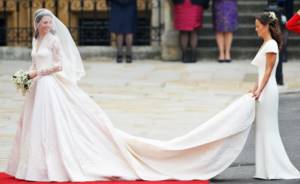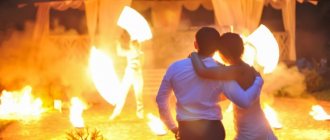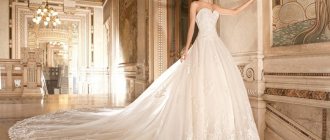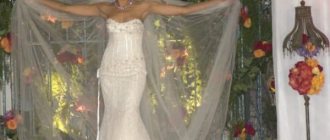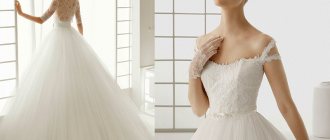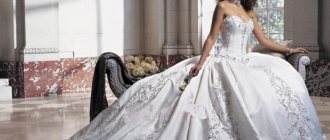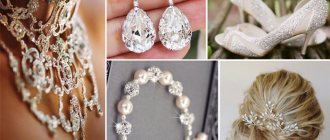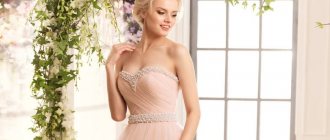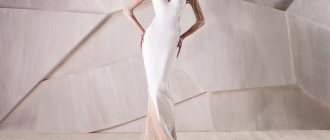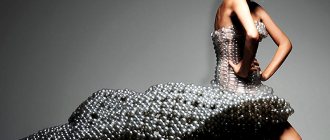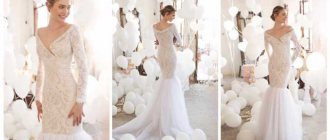Excursion into history
The bride in white is a symbol of purity and innocence. But this tradition is only 200 years old. In the old days, white was not a popular color for brides. It was considered mourning. In addition, it is very easily soiled and therefore expensive. There were a variety of colors for wedding decorations in Europe: red, green, purple.
The first time a bride was dressed in white was the wedding of Queen Anne of Brittany of France and Louis XII in 1499. More than 100 years later, the Anglo-Scottish Princess Elizabeth Stuart got married in a silver-white dress decorated with lace and diamonds.
At the wedding of Napoleon Bonaparte and Archduchess Marie-Louise of Austria in 1810, the bride also wore white.
The most famous newlywed who chose white is Queen Victoria. Her outfit was decorated with lace, orange flowers and a 5.5 meter train. After the royal wedding in 1849, many brides began to prefer white outfits and orange blossoms in their hair.
The first models of wedding dresses with a less magnificent cut date back to the 30s of the twentieth century. Dresses slightly below the knee with a straight cut and a minimal amount of decorative elements have come into fashion.
The Art Deco style also contributed to the classics of wedding dresses. He pleased with his straight lines and refined simplicity of silhouette. Additional elements here do not overload the outfit with voluminous decorations or shiny elements.
Retro
When planning a wedding in retro style, it is recommended to choose an appropriate lace or non-lace dress for a wedding that is not lush. In the selection below you will find a suitable wedding dress that is not lush: photos and interesting options in retro style.
Style Features
The top of the dress - a bodice with a corset - can be integral with the skirt, or can be worn separately. This part is especially highlighted in the classic cut style; it is decorated with the help of decorative elements: lace, ribbons, rhinestones.
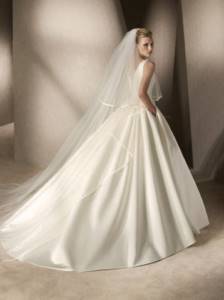
The skirt is not too full, it can be crinoline or sewn from several layers of fabric;
The length usually reaches the floor, but models with a length slightly below the knee are also acceptable;
The waist , in classic dresses, is emphasized with a belt, ribbon or the cut itself;
The train should not be too long and it is not always present in dresses with a classic cut;
The neckline should not be too deep and provocative. Also, thin straps are excluded. It is appropriate to sew the neckline and sleeves entirely from lace or decorate them partially with it.
The back should be covered with thick fabric, like the material of the dress, or with openwork lace.
Who wouldn't suit a curvy style?
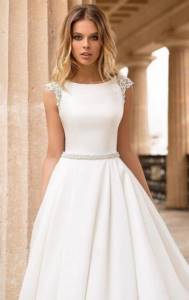
Any color scheme, and even more so any style, is considered permissible. This step in the development of the fashion industry can definitely be called progressive, since it allowed many girls to wear exactly the models that are most suitable. If previously it was accepted as a standard of beauty to wear only fluffy dresses, now the situation has changed dramatically. You can choose whatever you want. Thanks to this, non-lush wedding dresses have become increasingly common.
Not a fluffy wedding dress with an original and interesting cut, despite this, it will not suit every young lady.
It is worth noting the special type of figure on which such an outfit will look best. This wedding look is best suited for those girls who have an ideal figure.
This is considered the classic hourglass type. It is characterized by the same volume of hips and chest, and a clearly defined waist.
As a result, the dress completely fits her silhouette, emphasizing all the advantages of her figure.
There are many fabric options. In some the lady will look elegant, in others noble, in others - flirtatious.
Sometimes it is quite difficult to settle on the choice of a specific fabric, but it is quite possible. Especially if you manage to try on a variety of options.
If a girl has flaws in her figure, then they can also be hidden with the help of a dress that is not fluffy. For example, one of the best styles that can do this is Greek.
It is made of lightweight chiffon or silk fabric. As a result, it turns out that the fabric seems to glide over the figure. With the help of such a trick you can hide problems with the stomach and voluminous hips.
A sheath dress is a unique style of not fluffy outfit that suits absolutely everyone. Regardless of your body type, you can try on a similar look.
The length of this option is just below the knees. At the same time, it is made of dense satin or drape fabric, which hides any imperfections in the figure. The case is loved for the special elegance and aristocracy of the image it creates.
Retro-style clothing has become particularly popular lately. She is incredibly elegant. Clothing in the style of the Great Gatsby is especially appreciated now. This is America in the 20s and 30s. Women at that time looked incredibly feminine and romantic.
If the bride has long and beautiful legs, then they should definitely be highlighted and even emphasized. Therefore, the ideal case would be a straight long dress with a slit up to the hips.
In this look, the bride will amaze with her sexuality and luxurious appearance.
Models
Classics are always relevant, and the bride in such a dress will look elegant and magical. The styles of classic style wedding dresses are varied. And they all have their own indispensable canons.
"Princess"
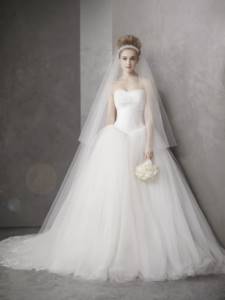
This option refers to curvy models, which are characterized by the presence of a tight corset and a very full skirt.
The top is decorated with embroidery, lace, beads, and rhinestones. It can be more open or have an off-the-shoulder design.
The skirt can consist of several layers of fabric or rest on a crinoline with 2-4 rings. There may be a train with different lengths.
Straight cut
It looks somewhat strict and reserved. But it can be diversified by using flowing fabrics or various decorative elements at the top of the model. It could be lace, flowers, rhinestones or sequins.
The outfit can have sleeves of different lengths or leave the shoulders open with a shallow neckline.
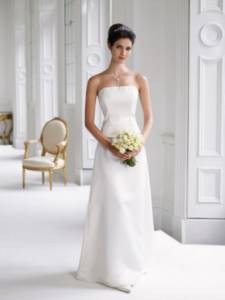
Materials and colors
Light fabrics - tulle, organza, chiffon are used when sewing fluffy dresses. Several layers of such fabric for a skirt will create the effect of lightness and airiness.
For straight-cut models, the basis is heavier material. Thanks to this solution, translucent chiffon lies on top in beautiful folds, softening the strict silhouette.
Satin will look great on curvy models. A petticoat made of lighter fabric will add volume to the skirt, and the dress will shine with a noble white color.

A straight dress made of satin fabric will look charming in its laconicism. When satin is used as a basis for light chiffon fabrics, it will create the effect of lightness and a flying silhouette.
Lace is considered a classic material for decoration. It is used for individual details of an outfit, inserts, or a dress can be sewn entirely from it.
A white wedding dress is a classic that does not lose its relevance, despite the modern diversity of the palette of wedding images.
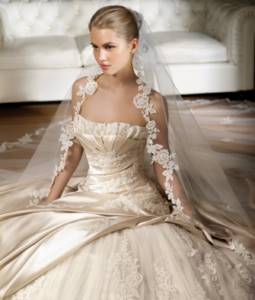
But white does not suit all brides. Girls with white skin will simply blend in with the material of the outfit. In this case, you can turn to shades of ivory, splashes of champagne, creamy or pearl. Paired with a classic outfit, they will help any bride choose the perfect look.
Classic wedding dress
Traditional wedding dresses allow us to conclude that although these are classic outfits, they are by no means trivial and monotonous. Certain details may vary, but some things remain the same, for example, the color white is one of the main components of a classic wedding dress.
It has long been considered synonymous with innocence and purity and was a symbol of marriage, and therefore in the classics it is static.
But due to physiological characteristics, not everyone can afford a snow-white outfit, so dresses in sister shades are allowed: beige, champagne, creme brulee, gray-white, ivory, pink-white and similar pastel colors. All of them do not contradict the standard image of the bride.
Accessories
The snow-white outfit with an airy veil on the newlywed delights and attracts the eye. White color adds solemnity to the event and festivity to the image.
The bride's image can only be complemented with accessories that completely match the style.
Therefore, if a store comes with a veil or gloves along with a dress, it is better to purchase the set right away. Then, you may not find anything more suitable in color, style and texture.
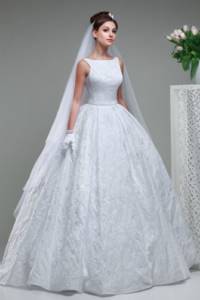
Veil. If the outfit has a full skirt, a full veil will fit here. It can be long, up to the elbow or to the fingertips. The veil can have lace trim around the edges or be made entirely of one material.
For a floor-length straight cut, the above options are also suitable. But if the length is just below the knee, then a shoulder-length option or a very short veil that opens the neck will go well with it.
A one- or two-layer veil would be ideal for the last two models.
A wreath or tiara will be a wonderful addition to the veil and dress. The tiara should not be too big and the wreath should not be too bright.
Shoes. Stiletto heeled pumps will harmonize perfectly with the outfit. You should not experiment with options for open sandals or low-top shoes.
Bolero or cape . For a wedding in the cold season, you can choose a bolero that suits the style, for example, made of lace or a fur cape. If it’s already winter weather outside, the outfit can be complemented with a fur coat made of natural or faux fur.
Decorations. One of the main rules of the classic style is moderation. If the top of the dress is decorated with lace, embroidery or rhinestones, it is better to abandon the choker or necklace.
Jewelry made of pearls or elegant items made of silver, gold, and base metals are well suited.
Gloves. For styles with short sleeves or sleeveless, gloves are worn above the elbow, tightly fitting the arm. They can be made of openwork or lace fabric, jacquard, taffeta.
Combining tradition and modernity
For those betrothed who prefer models of traditional colors, I advise you to pay attention to cream and milk ones, since they are closer than others to the usual white color, but at the same time more delicate and soft - they do not create a clear contrast with the skin.
A stylish feature will be an elegant cutout on the back, which can be:
- open and decorated with transparent fabric, embroidery, rhinestones;
- closed, with a row of slender buttons from the collar to the hem.
In this case, the front part of the bodice can even be closed right up to the collar, but the mystery and sexuality of this image will be ensured.
The most famous dresses of the XX-XXI centuries
Many famous brides preferred the classic style for their celebration. Royal weddings are a public event watched by thousands of eyes. The main role here belongs to the bride. It is her image that will maintain the atmosphere of the holiday of love, beauty and tenderness.
The future Queen Elizabeth II married in 1947. It was a difficult post-war time of economy and the rationing system. Girls from all over the world sent her coupons for sewing a decent dress. We made an outfit from cream-colored duchess satin. The top and hem were symmetrically embroidered with pearl flowers. The attire was completed with a lace veil.

Jacqueline Kennedy's dress was made according to the fashion of its time with a full skirt and a deep neckline. The fabric of the outfit is ivory silk taffeta. The veil that adorned the bride's head belonged to her grandmother.
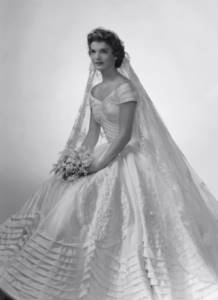
Grace Kelly received her wedding dress as a gift from Metro-Goldwyn-Mayer. Made from silk taffeta and lace decorated with pearls, it is still considered a style standard today.

Princess Diana's dress is lush, luxurious and fabulous. It was made of ivory silk taffeta and decorated with pearls and antique handmade lace. A distinctive feature was the train, almost 8 meters long. Now, of course, it no longer looks so relevant, but it undoubtedly left its mark on history.
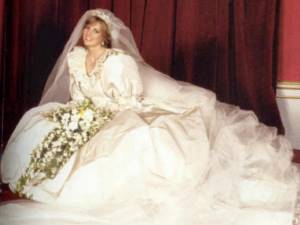
Kate Middleton is a 21st century bride, whose dress has also become one of the examples of classic style. The snow-white outfit with a 3-meter train was decorated with lace depicting flowers - symbols of Great Britain.
